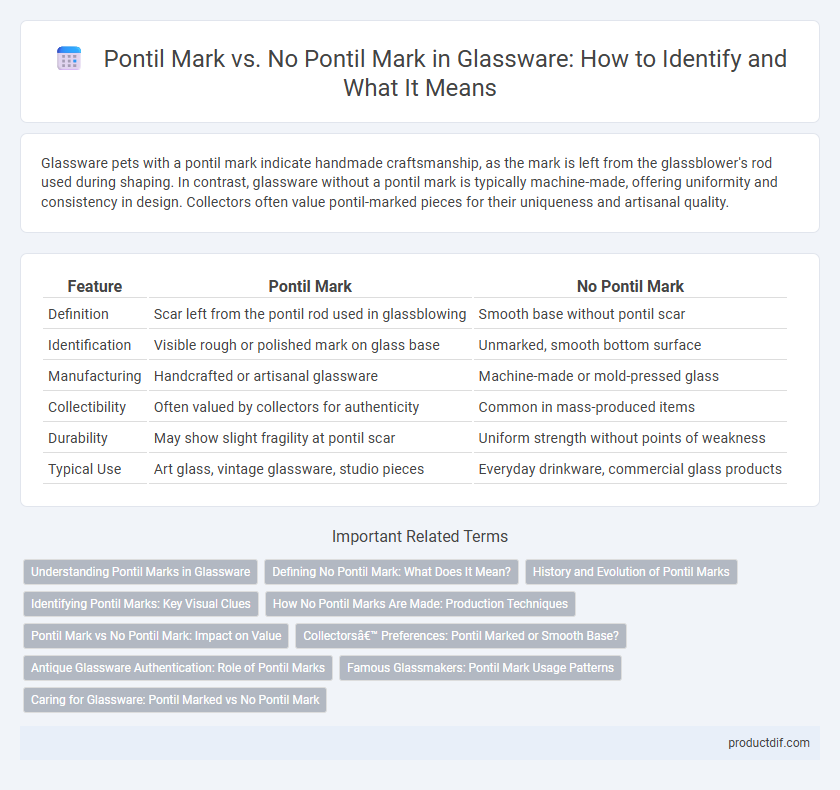Glassware pets with a pontil mark indicate handmade craftsmanship, as the mark is left from the glassblower's rod used during shaping. In contrast, glassware without a pontil mark is typically machine-made, offering uniformity and consistency in design. Collectors often value pontil-marked pieces for their uniqueness and artisanal quality.
Table of Comparison
| Feature | Pontil Mark | No Pontil Mark |
|---|---|---|
| Definition | Scar left from the pontil rod used in glassblowing | Smooth base without pontil scar |
| Identification | Visible rough or polished mark on glass base | Unmarked, smooth bottom surface |
| Manufacturing | Handcrafted or artisanal glassware | Machine-made or mold-pressed glass |
| Collectibility | Often valued by collectors for authenticity | Common in mass-produced items |
| Durability | May show slight fragility at pontil scar | Uniform strength without points of weakness |
| Typical Use | Art glass, vintage glassware, studio pieces | Everyday drinkware, commercial glass products |
Understanding Pontil Marks in Glassware
Pontil marks in glassware indicate where the glass was detached from the pontil rod during the hand-blowing process, often signaling authentic, handcrafted pieces. Glassware without a pontil mark is typically machine-made or polished to remove the pontil scar, suggesting mass production or a high-finish technique. Collectors value pontil marks for their role in verifying the age, origin, and craftsmanship of vintage and artisanal glass items.
Defining No Pontil Mark: What Does It Mean?
No pontil mark on glassware indicates the piece was finished without breaking the connection to the glassblower's rod, often resulting in a smoother base and enhanced aesthetic appeal. This absence can signify machine-made or mold-blown glass, distinguishing it from hand-blown items where the pontil mark reveals the detachment point. Collectors value no pontil mark pieces for their uniformity and modern manufacturing precision.
History and Evolution of Pontil Marks
Pontil marks originated during the glassblowing process where the molten glass was detached from the pontil rod, leaving a distinct scar that served as a hallmark of handcrafted glassware. Historically, the presence of a pontil mark indicated authentic, artisanal craftsmanship typical of antique and vintage glass pieces, while the absence of such marks in modern glassware often reflects advancements in automated manufacturing techniques. The evolution from prominent pontil marks to polished or concealed pontil scars mirrors technological progress in glass production and changing consumer preferences for seamless finishes.
Identifying Pontil Marks: Key Visual Clues
Pontil marks are distinctive scars or rough patches found on the base of hand-blown glassware, indicating where the glassblower's pontil rod was attached during shaping. Glass items without pontil marks usually exhibit a smooth, polished base, often indicative of machine-made production or refined finishing techniques. Identifying these key visual clues aids collectors and enthusiasts in distinguishing authentic artisanal glass from mass-produced pieces.
How No Pontil Marks Are Made: Production Techniques
No pontil marks are created through production techniques that eliminate the need for attaching a rod during glass shaping, such as mold blowing or machine pressing. These methods involve forming the glass inside molds or using automated machines, ensuring a smooth base without the rough scar typical of pontil marks. This results in a cleaner finish often found in mass-produced glassware, enhancing both aesthetics and structural integrity.
Pontil Mark vs No Pontil Mark: Impact on Value
Pontil marks on glassware indicate hand-blown craftsmanship, often enhancing the piece's value due to their association with traditional artisanal techniques and uniqueness. Glass items without pontil marks typically result from machine production, which may lower their collectible appeal and market price compared to hand-finished pieces. Consequently, the presence or absence of a pontil mark significantly influences the glassware's provenance, rarity, and ultimately, its monetary worth.
Collectors’ Preferences: Pontil Marked or Smooth Base?
Collectors often favor glassware with pontil marks as these indicate hand-blown craftsmanship, enhancing the piece's authenticity and historical value. Smooth bases typically suggest mold-made production, appealing to those who prioritize uniformity and modern manufacturing. Preference varies, but many collectors prize pontil marks for their uniqueness and connection to traditional glassblowing techniques.
Antique Glassware Authentication: Role of Pontil Marks
Pontil marks serve as crucial indicators in authenticating antique glassware by revealing hand-crafted origins, distinguishing pieces made before automated production methods. The presence of a pontil mark typically signifies that the glass item was individually shaped and finished by a glassblower, enhancing its historical and collectible value. Conversely, the absence of a pontil mark often suggests machine-made or later-period glassware, which can help experts determine the age and authenticity of the piece.
Famous Glassmakers: Pontil Mark Usage Patterns
Famous glassmakers like Tiffany Studios and Lundberg Studios often left distinct pontil marks as a signature of handcrafted authenticity, while companies such as Fenton and Murano glass more commonly produced no pontil mark pieces to highlight seamless finishing. The presence or absence of a pontil mark serves as a key identifier of production techniques and craft traditions in high-end glassware. Collectors value pontil marks for confirming hand-blown origins, whereas smooth bases without pontil scars often indicate mold-blown or machine-assisted manufacturing.
Caring for Glassware: Pontil Marked vs No Pontil Mark
Pontil marked glassware requires gentle handling and cleaning to avoid chipping or cracking at the rough base where the pontil was broken off, while no pontil mark glassware typically has a smooth, polished base allowing for more resilient everyday use. When caring for pontil marked pieces, use soft cloths and avoid abrasive scrubbers, as the exposed pontil scar is more susceptible to damage. In contrast, glassware without a pontil mark can withstand regular dishwasher cycles, but handwashing with mild detergent is still recommended to maintain clarity and shine.
Pontil mark vs no pontil mark Infographic

 productdif.com
productdif.com